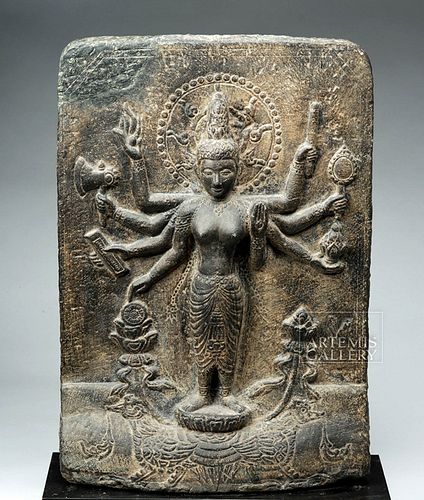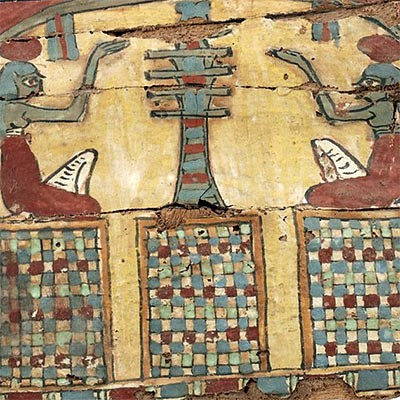12th C. Indian Pala Stone Stele - Parvati w/ Peahen
Lot 58a
About Seller
Artemis Fine Arts
686 S Taylor Ave, Ste 106
Louisville, CO 80027
United States
Selling antiquities, ancient and ethnographic art online since 1993, Artemis Gallery specializes in Classical Antiquities (Egyptian, Greek, Roman, Near Eastern), Asian, Pre-Columbian, African / Tribal / Oceanographic art. Our extensive inventory includes pottery, stone, metal, wood, glass and textil...Read more
Categories
Estimate:
$15,000 - $20,000
Absentee vs Live bid
Two ways to bid:
- Leave a max absentee bid and the platform will bid on your behalf up to your maximum bid during the live auction.
- Bid live during the auction and your bids will be submitted real-time to the auctioneer.
Bid Increments
| Price | Bid Increment |
|---|---|
| $0 | $25 |
| $300 | $50 |
| $1,000 | $100 |
| $2,000 | $250 |
| $5,000 | $500 |
| $10,000 | $1,000 |
| $20,000 | $2,500 |
| $50,000 | $5,000 |
| $100,000 | $10,000 |
| $200,000 | $20,000 |
About Auction
By Artemis Fine Arts
Jul 30, 2020
Set Reminder
2020-07-30 10:00:00
2020-07-30 10:00:00
America/New_York
Bidsquare
Bidsquare : Ancient / Ethnographic From Around the World
https://www.bidsquare.com/auctions/artemis-gallery/ancient-ethnographic-from-around-the-world-5382
Ancient art from Egypt, Greece, Italy and the Near East, as well as Asian, Pre-Columbian, Native American, African / Tribal / Oceanic, Spanish Colonial, Russian Icons, Fine art, much more! All categories, all price ranges... all legally acquired and guaranteed to be as described or your money back. Artemis Fine Arts info@artemisgallery.com
Ancient art from Egypt, Greece, Italy and the Near East, as well as Asian, Pre-Columbian, Native American, African / Tribal / Oceanic, Spanish Colonial, Russian Icons, Fine art, much more! All categories, all price ranges... all legally acquired and guaranteed to be as described or your money back. Artemis Fine Arts info@artemisgallery.com
- Lot Description
Northeastern India, Pala Period, ca. 12th century CE. A finely carved black stone stele depicting the deity Parvati, goddess of love and family adored for her assistance in marriage, fertility, and parenting. She is the daughter of king Himavan and Queen Mena, consort of Shiva, and mother to Ganesha and Kartikeya. In addition, the Puranas describe her as sister to Lord Vishnu and river goddess Ganga. She appears in many manifestations, sometimes as Durga or Kali with eight or ten arms. Here she presents eight arms which are indicators of her divine nature that carry symbolic implements (such as a flame, a mirror - a symbol associated with Shiva and a sign of wisdom and the emptiness of worldly matters, a flute, a pomegranate symbolizing fertility, an axe, and a scroll that may refer to the Puranas). The goddess stands upon a lotus pedestal carried by a pair of peahens with floral blossoms in their mouths. See more about this iconography below. Size: 17.625" W x 24.5" H (44.8 cm x 62.2 cm); 27.125" H (68.9 cm) on included custom stand.
Kapaleswarar Temple, one of the most famous in Chennai, is located in what is today known as Mylapore (Mayilapur) which means "City of the Peacock." A legend of the Puranas (sacred Sanskrit writings) tells of Parvati's association with the peacock. According to the story, when Lord Shiva was attempting to impart his pearls of wisdom to Parvati, she was suddenly distracted by a peacock. Upset by this, Shiva cursed her and ordered her to take birth as a peahen, declaring that he would later join her after she worshipped him in the form of Shiva Lingham under a Punnai tree. It took years and years of searching, but the peahen finally discovered a Shiva Lingham in Mylapore. Upon finding Shiva Lingham, Parvati (as a peahen) worshipped Lord Shiva, carrying floral blossoms to him in her beak. At once, Lord Shiva then reunited with Parvati.
Carved from black basalt, a stone that was popular among sculptors during the Pala and Sena periods in northeastern India and in what is now Bangladesh, this stele most likely once occupied a niche within a temple to served as a focus of worship.
A black stone stele created during the Pala Period and depicting Vishnu sold for $47,500 at Christie's New York (Sale 14484, lot 616) on September 13, 2017.
Provenance: ex-collection of Medill Sarkisian, Sarkisian Gallery, Denver, Colorado, USA, collected in the 1950's
All items legal to buy/sell under U.S. Statute covering cultural patrimony Code 2600, CHAPTER 14, and are guaranteed to be as described or your money back.
A Certificate of Authenticity will accompany all winning bids.
We ship worldwide and handle all shipping in-house for your convenience.
#131805Expected surface wear commensurate with age, but imagery is still very clear. Abraded areas at the peripheriesCondition
- Shipping Info
-
All shipping is handled in-house for your convenience. Your invoice from Artemis Gallery will include shipping calculation instructions. If in doubt, please inquire BEFORE bidding for estimated shipping costs for individual items.
-
- Buyer's Premium



 EUR
EUR CAD
CAD AUD
AUD GBP
GBP MXN
MXN HKD
HKD CNY
CNY MYR
MYR SEK
SEK SGD
SGD CHF
CHF THB
THB




















